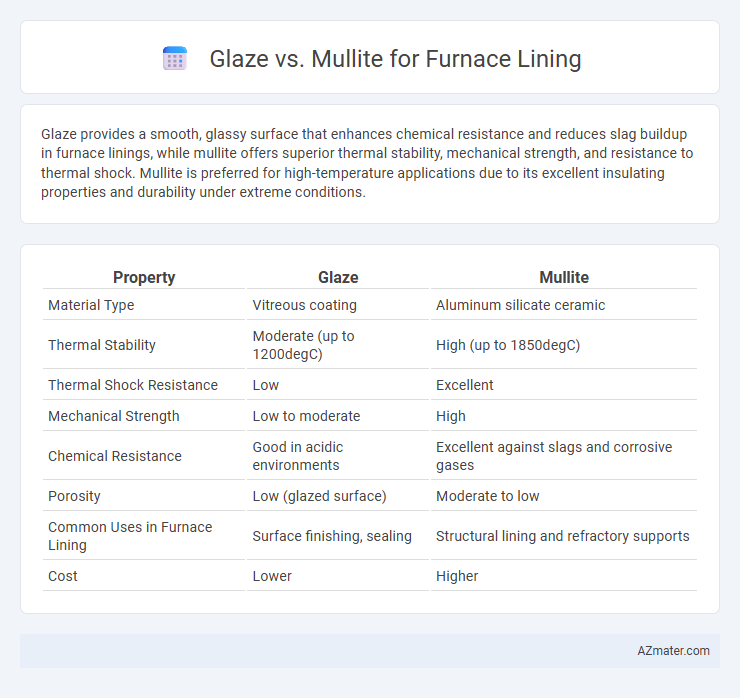Glaze provides a smooth, glassy surface that enhances chemical resistance and reduces slag buildup in furnace linings, while mullite offers superior thermal stability, mechanical strength, and resistance to thermal shock. Mullite is preferred for high-temperature applications due to its excellent insulating properties and durability under extreme conditions.
Table of Comparison
| Property | Glaze | Mullite |
|---|---|---|
| Material Type | Vitreous coating | Aluminum silicate ceramic |
| Thermal Stability | Moderate (up to 1200degC) | High (up to 1850degC) |
| Thermal Shock Resistance | Low | Excellent |
| Mechanical Strength | Low to moderate | High |
| Chemical Resistance | Good in acidic environments | Excellent against slags and corrosive gases |
| Porosity | Low (glazed surface) | Moderate to low |
| Common Uses in Furnace Lining | Surface finishing, sealing | Structural lining and refractory supports |
| Cost | Lower | Higher |
Introduction to Furnace Lining Materials
Furnace lining materials are crucial for thermal insulation, structural integrity, and resistance to high temperatures and chemical corrosion. Glaze, a vitreous coating, offers smooth surfaces with moderate thermal resistance, while mullite, a crystalline aluminosilicate mineral, provides superior thermal stability and mechanical strength at temperatures exceeding 1700degC. Selecting between glaze and mullite depends on operational conditions, including temperature cycles, chemical exposure, and desired insulation properties for optimal furnace performance.
Understanding Glaze: Composition and Properties
Glaze for furnace lining primarily consists of silica, alumina, and fluxing agents that create a glassy, impermeable surface when fired, enhancing chemical resistance and thermal insulation. Its viscous nature at high temperatures allows it to form a smooth, protective coating that prevents slag and ash buildup while minimizing corrosion. The composition's balance between melting point and thermal expansion is critical to maintain structural integrity under thermal cycling conditions in furnace environments.
Mullite Explained: Structure and Characteristics
Mullite is a highly stable alumino-silicate mineral with the chemical formula 3Al2O3*2SiO2, known for its exceptional thermal resistance and low thermal expansion, making it ideal for furnace linings. Its orthorhombic crystal structure provides high mechanical strength and excellent corrosion resistance to molten slags and combustion gases at temperatures exceeding 1700degC. Mullite's unique combination of low thermal conductivity and structural integrity ensures enhanced furnace efficiency and prolonged refractory lifespan compared to traditional glaze linings.
Key Performance Differences: Glaze vs. Mullite
Glaze offers a smooth, glass-like surface that enhances chemical resistance and reduces thermal shock for furnace linings, whereas mullite provides superior mechanical strength and high-temperature stability due to its alumina-silica composition. Mullite's low thermal expansion and excellent thermal shock resistance make it ideal for refractory linings that encounter rapid temperature changes. Glaze, while less durable under extreme thermal cycling, improves corrosion resistance and surface hardness, making it suitable for protective furnace coatings where chemical attack is a primary concern.
Thermal Stability and Resistance Comparison
Mullite offers superior thermal stability compared to glaze, maintaining structural integrity in furnace linings at temperatures above 1750degC, whereas glazes typically degrade or soften beyond 1200degC. Mullite's crystalline structure provides enhanced resistance to thermal shock and chemical corrosion, making it a preferred choice in high-temperature industrial applications. In contrast, glazes, being amorphous coatings, provide limited thermal durability and are more susceptible to cracking under prolonged thermal cycling.
Chemical Resistance in Industrial Environments
Glaze offers superior chemical resistance due to its dense, vitrified surface that prevents corrosive agents from penetrating, making it ideal for furnace linings exposed to acidic or alkaline slags. Mullite, composed of alumina and silica, provides excellent thermal stability and moderate chemical resistance but can be more susceptible to attack by aggressive chemicals in industrial environments. Selecting glaze over mullite enhances furnace lining durability by minimizing degradation from chemical exposure in high-temperature processes.
Installation and Maintenance Considerations
Glaze furnace linings offer a smooth, glass-like surface that simplifies cleaning and reduces particulate buildup, making maintenance quicker and less labor-intensive compared to mullite linings. Mullite linings, known for their high thermal shock resistance and durability, require more careful installation to ensure proper bonding and avoid cracks, leading to longer initial setup times. Maintenance of mullite involves periodic inspections for structural integrity, while glaze surfaces mainly need monitoring for coating wear and potential reapplication.
Cost and Longevity of Glaze and Mullite Linings
Glaze linings for furnace applications offer lower initial costs but typically have shorter lifespans due to their susceptibility to thermal shock and chemical corrosion, resulting in more frequent replacements. Mullite linings, although more expensive upfront, provide superior longevity because of their high thermal stability, resistance to abrasion, and excellent refractoriness, making them cost-effective over time. Investing in mullite linings reduces maintenance costs and downtime, enhancing overall furnace efficiency and durability.
Suitability for Various Furnace Types
Glaze offers excellent chemical resistance and smooth surfaces ideal for electric and glass melting furnaces, enhancing durability against slag and flux attack. Mullite provides superior thermal shock resistance and stability, making it suitable for high-temperature industrial kilns and gas-fired furnaces where repeated heating cycles occur. Selecting between glaze and mullite depends on the furnace's operating temperature, atmosphere, and mechanical stress conditions to maximize lining longevity.
Choosing the Right Lining: Glaze or Mullite?
Choosing the right furnace lining between glaze and mullite depends on the specific operational conditions and desired durability. Glaze offers excellent protection against chemical corrosion and is ideal for applications requiring a smooth, impermeable surface, while mullite provides superior thermal stability and resistance to mechanical wear at high temperatures. Evaluating the furnace's temperature range, exposure to corrosive materials, and maintenance requirements is essential to select the optimal lining for longevity and performance.

Infographic: Glaze vs Mullite for Furnace Lining
 azmater.com
azmater.com